Use the Circle of Fifths to Build Scales
The Circle of Fifths is a great tool for learning and applying music theory concepts. Everybody agrees on that. However, most people don't really know everything that it can do. Here is one way you can use it that most people don't know about!
Notes Instead of Chords
Most people think of the Circle of Fifths as simply a tool for working out chord progressions. While it is definitely great at that, it is also a super easy way to work out major and minor scales.
Most of the time, the letters in the circle are referring to a chord. However, we can also use these letters to talk about particular notes in any scale we want to use. Here's how it works.
Leap Frog
We're going to play a game of leap frog with the circle of fifths. We can start on any note (we'll use C) and skip around to make a major scale. All major scales are made of the following set of whole steps and half steps:
WWHWWWH = (This means whole, whole, half, whole, whole, whole, half)
for more about this, click here .
Here's what we do. For the whole steps, we jump over the note to the right. (Or you can think about just moving two notes to the right.) For the half steps, we jump across the circle, then go one note to the right.
So let's get started. First we'll jump from C (over the G) to D.
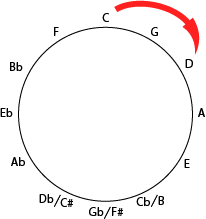
Now we do this again to go from D (over the A) to E.
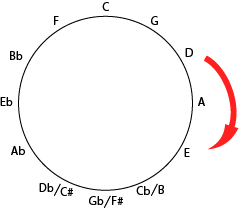
Now here is where this technique can seem a little strange. We have a half step now,(WWHWWWH) so we're going to cross the circle and go to the right.
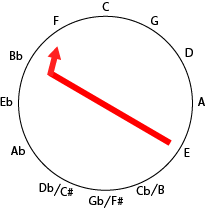
Note: This is still leap frog. We're jumping straight across the circle and leaping over whatever note we come to, going to the right.
Now we continue with the whole steps the same way we did before. Just jump over the note to the right.
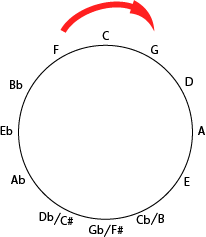
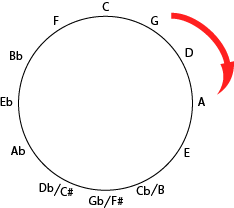
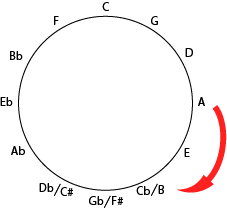
And now we have come to the last half step, so again, we cross the circle of fifths and go to the right.
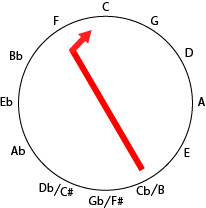
So for this C scale we just completed, this technique gives us the notes
C D E F G A B C,
which is the correct scale.
Also, try this technique with any minor scale. It works exactly the same way, you just use the whole-step/half-step pattern for the minor scale (WHWWHWW) instead.
Click here for more on minor scales.
The Problem
That's right. This technique is not perfect. Well, it kind of is, you just get some funny note names.
See, here's the problem. This leap frog game works great for C major and A minor. It even works perfectly fine for most scales. However, when you try to use a C♭, or keys that have more than 2 sharps, the note names don't work out right.
NOTICE: THIS DOES NOT MEAN THE NOTES ARE WRONG. The notes will sound exactly the same. This only means that the names of the notes won't be right. For instance, here is an A scale with this technique.
A B C♯ D E F♯ A♭ A
See the problem? We have two notes with the letter A, and we're missing a note with a G. (In case you're confused, major and minor scales are supposed to contain exactly one of every letter name: no more, no less.)
Here is what it is supposed to look like.
A B C♯ D E F♯ G♯ A
You could rewrite the circle of fifths and rename all of the flat notes into sharps, but it's not really practical. If you really love this technique though, feel free to do exactly that.
Once you get better at doing this, you can just rename the notes in your head as you go.
A Useful Technique
So this technique isn't always the fastest solution, but it is really simple, and it's a great way to get started with scales.
One reason I love this technique is because it is both easy to teach, and easy to learn. Some of my music students who are, let's say, "hesitant" to learn theory, will balk at learning the scales. Okay, they HATE scales. However, when I show them this technique, they usually say something like, "Oh, wow, that was actually easier than I thought," or "Geez, why couldn't you have shown me this sooner?!"
Beginner or pro, try it for yourself. I bet you'll find it useful at times.
Return from Circle of Fifths - Scales to Homepage
Hope this helps! Practice hard and let me know if you have any questions!